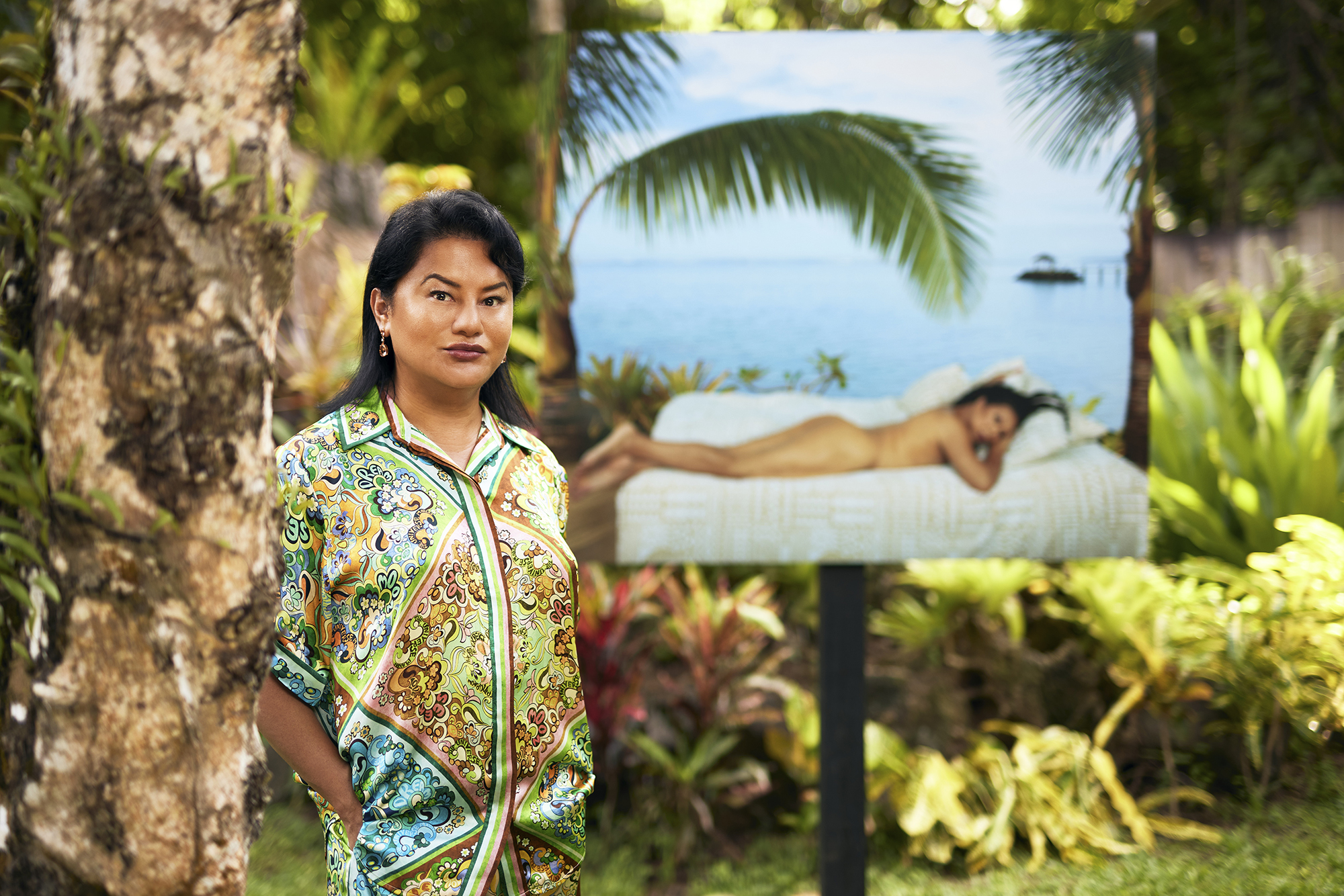A trip into the expansive world of the Japanese-Sāmoan artist, where a reconsideration of what it means to be human requires a reevaluation of the origin of the species
Charles Darwin sighs. “I kept a secret about the queer animal queendom,” he confesses. He looks a little off: his face is doughy and pallid; he seems forlorn as he rocks back and forth in an armchair. “Because I was afraid of being cancelled by the Victorian establishment.” Moments later, he is instantly transported from his chair and what appears to be a private members’ club, to a brightly coloured coral reef. And outfitted in a glorious clownfish-inspired gown.
This is the beginning of Japanese-Sāmoan artist Yuki Kihara’s most recent video, Darwin Drag (2025). For more than two decades, her multidisciplinary output of photography, performance, moving image, sculpture and archival research has sought to interrogate colonial visual-culture and dismantle the historical Western gaze cast on the bodies and sexuality of Indigenous peoples in the South Pacific. Recently, she has also looked to the intersection of gender-based and racial prejudices, resource extraction and the human impact on the environment around the South Seas and, more broadly, the Pacific Ocean.
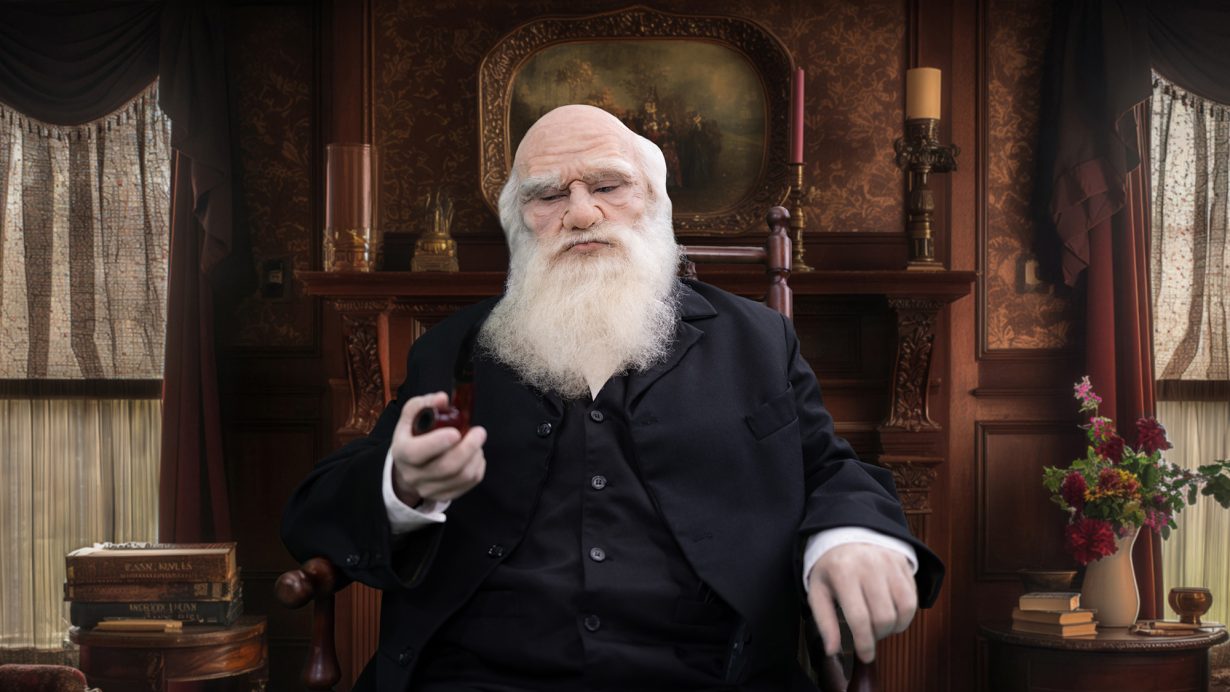
In Darwin Drag, the eponymous British biologist (played by Kihara, who wears extensive prosthetics for the role) is given the opportunity to reflect on omissions regarding the variety of sex traits catalogued in On the Origin of Species (1859), a piece of scientific literature that is considered foundational to the field of evolutionary biology. In the video, drag queen-cum-fairy fishmother BUCKWHEAT (aka Lealailepule Edward Cowley, a collaborator and professional drag queen working in Aotearoa New Zealand) takes Darwin under her fin, and together they travel a coral reef, exploring several fish species that exhibit sequential hermaphroditism (ie they can change sex). It’s a biological trait that was observed (recorded in Darwin’s notebooks) but downplayed, along with any sexual display that deviated from the binary female-male reproductive model, by Darwin and his peers. (Darwin refers to ‘vitiated’ – impaired – instincts in Origin when observing nonhuman animals and plants whose reproductive natures are highly sensitive to changes in environmental or social conditions.)
All clownfish (known in Sāmoa as tu’u’u-lumane, BUCKWHEAT tells us) are born male. In a group of clownfish the dominant male will turn into a female fish. She’ll lay eggs and her mate will fertilise those. When the female dies, her mate or the next largest male will take her place. This change is called protandrous hermaphroditism, we learn from the six-minute video. Some female globehead parrot-fish (fuga), which are less vivid in colour, will change into vibrant blue-green male fish when they reach sexual maturity (protogynous hermaphroditism), while the coral goby (mano’o) can change back and forth between sexes (bidirectional hermaphroditism). “The mano’o are introverts and hardly move around, so their chances of looking for a new mate is pretty slim,” explains Darwin in Kihara’s videowork. “Hence, when two mano’o meet, any possibility of a sex change would surely come in handy!” chimes in BUCKWHEAT, now dressed as a parrotfish. Rita Menu (Shayden Taylor) and Tess Tickle (Mizac Hotere) are dressed in peach-and gold-ruffled goby-inspired dresses, shimmying up against one another and applying makeup; Rita applies highlighter to her own cheekbones, while Tess, with a suggestive smile, begins to paint on a goatee. Darwin proceeds to tell us that another kind of hermaphroditism is called ‘synchronous’, meaning both male and female reproductive organs are present at the same time: “That reminds me of the pusi!” smiles BUCKWHEAT, referring to the fimbriated moray eel. There’s a good dose of cheeky subversiveness in Darwin Drag, which upends the conventionally serious, observational approach of the television nature-documentaries that we are accustomed to with a disco-soundtracked drag aesthetic.
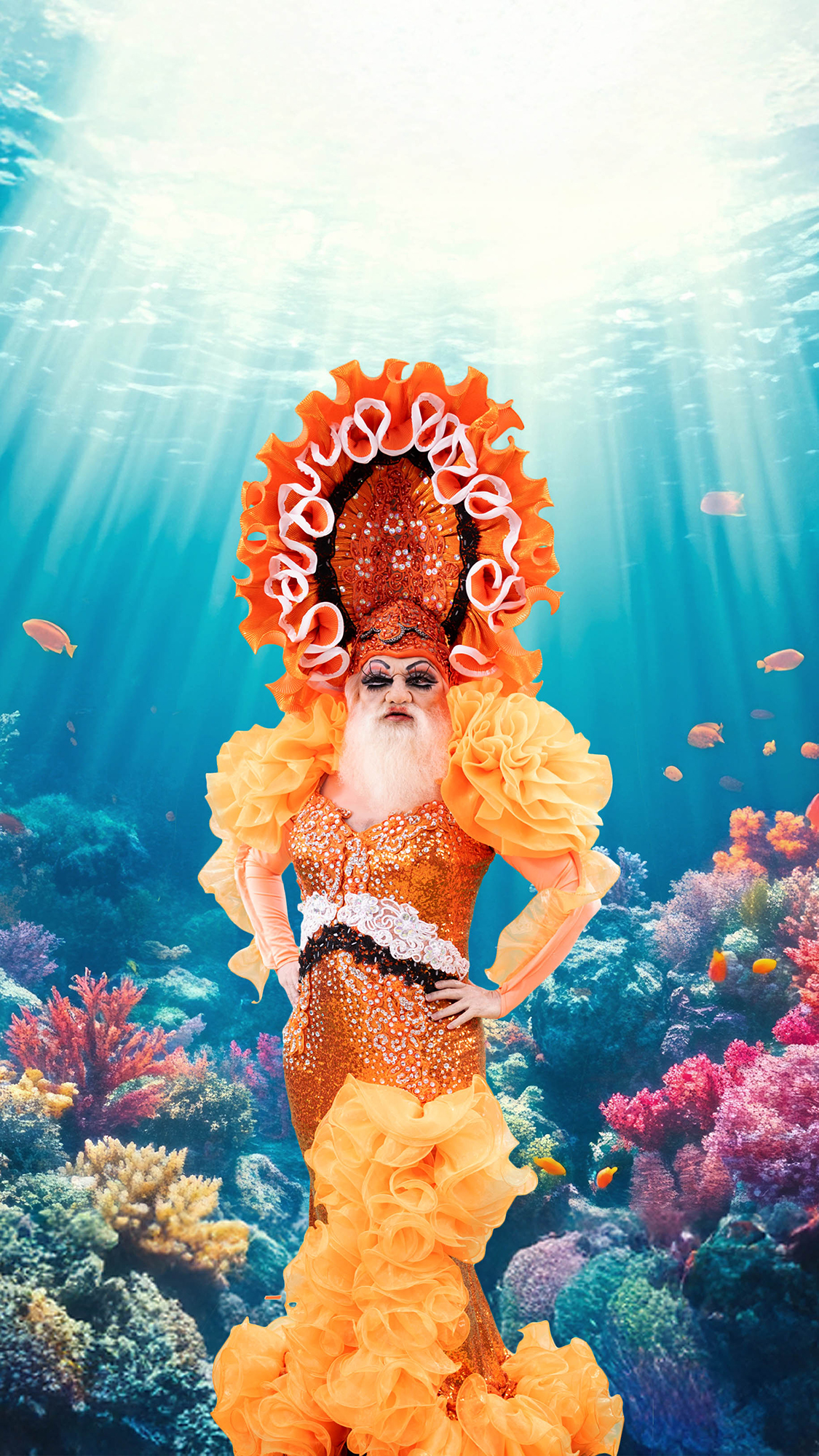
The same is true of Paradise Camp, an ongoing project begun in 2020 (of which Darwin Drag is a part) and that has formed the backbone of Kihara’s work since touring from the New Zealand Pavilion at the 59th Venice Biennale to the Powerhouse Museum in Gadigal land, Sydney, and Saletoga Sands Resort & Spa in Sāmoa. Kihara has just opened her latest instalment, titled Darwin in Paradise Camp, at the Sainsbury Centre in Norwich. Each iteration of Paradise Camp has featured photographs, moving image, sculptures, textiles, performance and an archive that includes museum documentation, newspaper articles, photographs, illustrations and more, all of which are installed in the fashion of a natural-history-museum exhibition. At Darwin in Paradise Camp, for example, opposite a display of preserved fish specimens, one vitrine displays the prosthetic of Darwin’s face and hair that Kihara wore for the video. Propped up on a mount, the mask looks like a flap of shed skin or the surface of a head waiting to be taxidermied; in the same vitrine are the moulds used to cast the contours of Kihara’s head. There’s a sharp but playful irony to the way Kihara subverts the traditional Western model of museum display and its epistemic violences – that is, the ways in which museums are responsible for recording and shaping its society’s knowledge, a system that has both historically ignored or overlooked Indigenous sexuality and at the same time othered and fetishised Indigenous bodies. Here, Kihara uses the vitrine not only to display the biologist as a specimen but also as a kind of double portrait, one that reveals the inside of Darwin’s face to be shaped by a person that he and the establishment to which he belonged – put simply, one that privileged white heterosexual Christian men – would have deemed ‘vitiated’ or ‘unnatural’. And covered up.
Kihara is Fa’afafine and Paradise Camp is conceived of as a Fa’afafine utopia. Fa’afafine (meaning ‘in the manner of a woman’) is a term that refers to third gender people in Sāmoa who are born male, and raised and identify with female gender traits. (For those who are assigned female at birth and embody masculine gender traits, Fa’atane means ‘in the manner of a man’.) Third genders are not based on sexual identity, but on gender and spirituality, and exist across the world, each an accepted group of people within their cultures: in North America, there are two-spirit people; in India, the hijra; in Balkan cultures there are sworn virgins; in Thailand, the kathoey. “Paradise Camp is a place where no one is discriminated for their gender or their sexuality,” explains Kihara. “It’s a place where we live in harmony with nature. That’s always been the ethos of Paradise Camp: to look at the natural environment from an Indigenous queer perspective.”
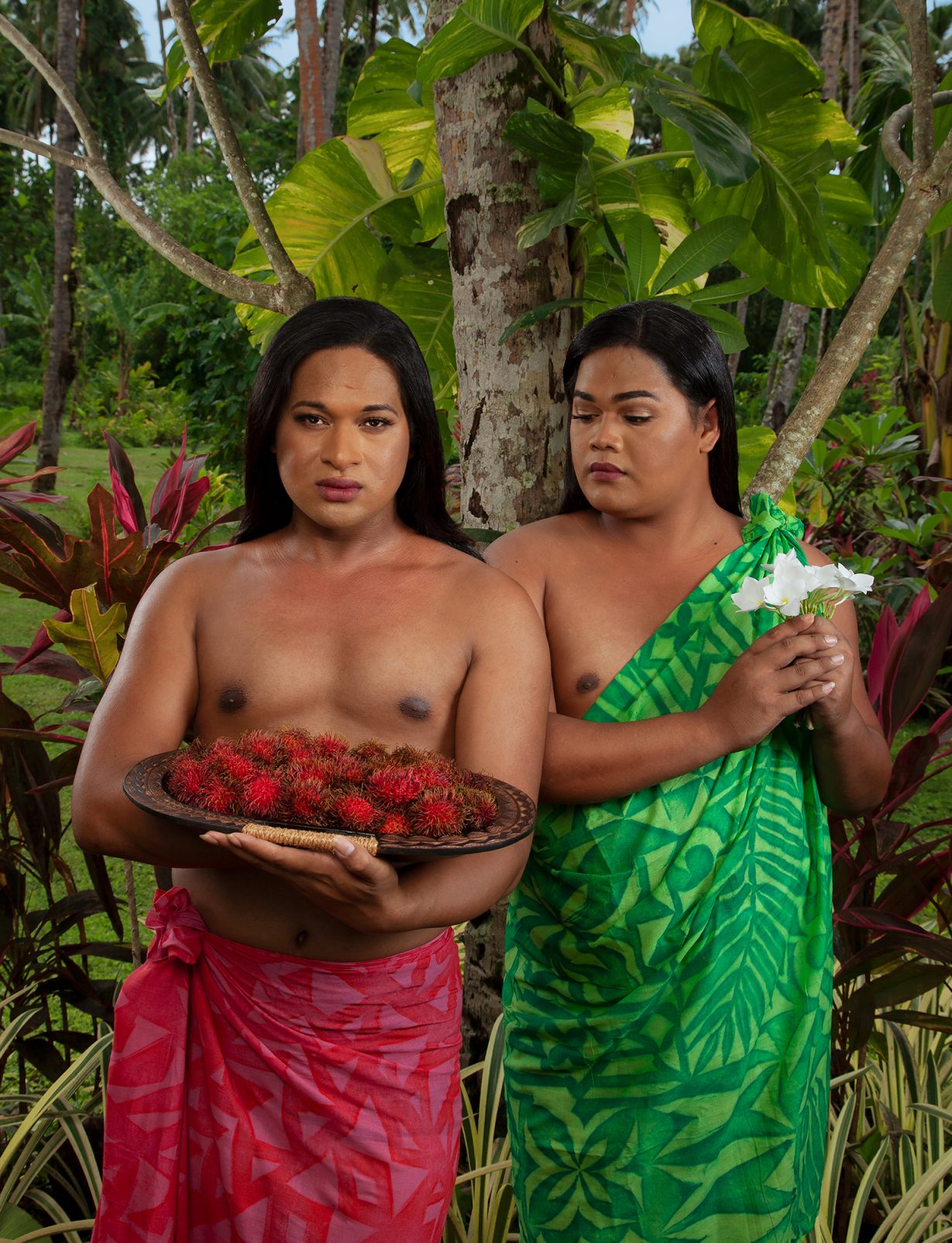
What makes Kihara’s work so compelling is the way in which she creates points of access for different audiences. The series After Gauguin (2020) recreates the French artist’s paintings of Tahitian women via photographs that depict members from the Fa’afafine and Fa’atane community, to which Kihara belongs, reprising the poses. Finding, in her research, that several of Gauguin’s paintings likely lifted Sāmoan figures and landscapes from photographs taken by New Zealand photographer Thomas Andrew at the turn of the twentieth century, Kihara subverts the exoticising and fetishising Western gaze upon Pacific Islanders’ bodies by repicturing these paintings with Fa’afafine collaborators and centring the idea of self-representation. The models, far from the passive subjects of Gauguin’s paintings, gaze coyly, smoulder, stare knowingly, glare or look at viewers with a softened, compassionate expression. After all, ‘The title of my exhibition is intended to “camp” the notion of “paradise”,’ Kihara told Natalie King, who curated the exhibition’s presentation at the Venice Biennale. This quality is evident in Darwin Drag, too, which sits somewhere between a drag performance, environmental campaign advert, a kids’ programme. But Kihara undercuts her sense of humour by consistently pointing to the subjects of colonialism, the violences of heteronormativity and the human impact on the environment.
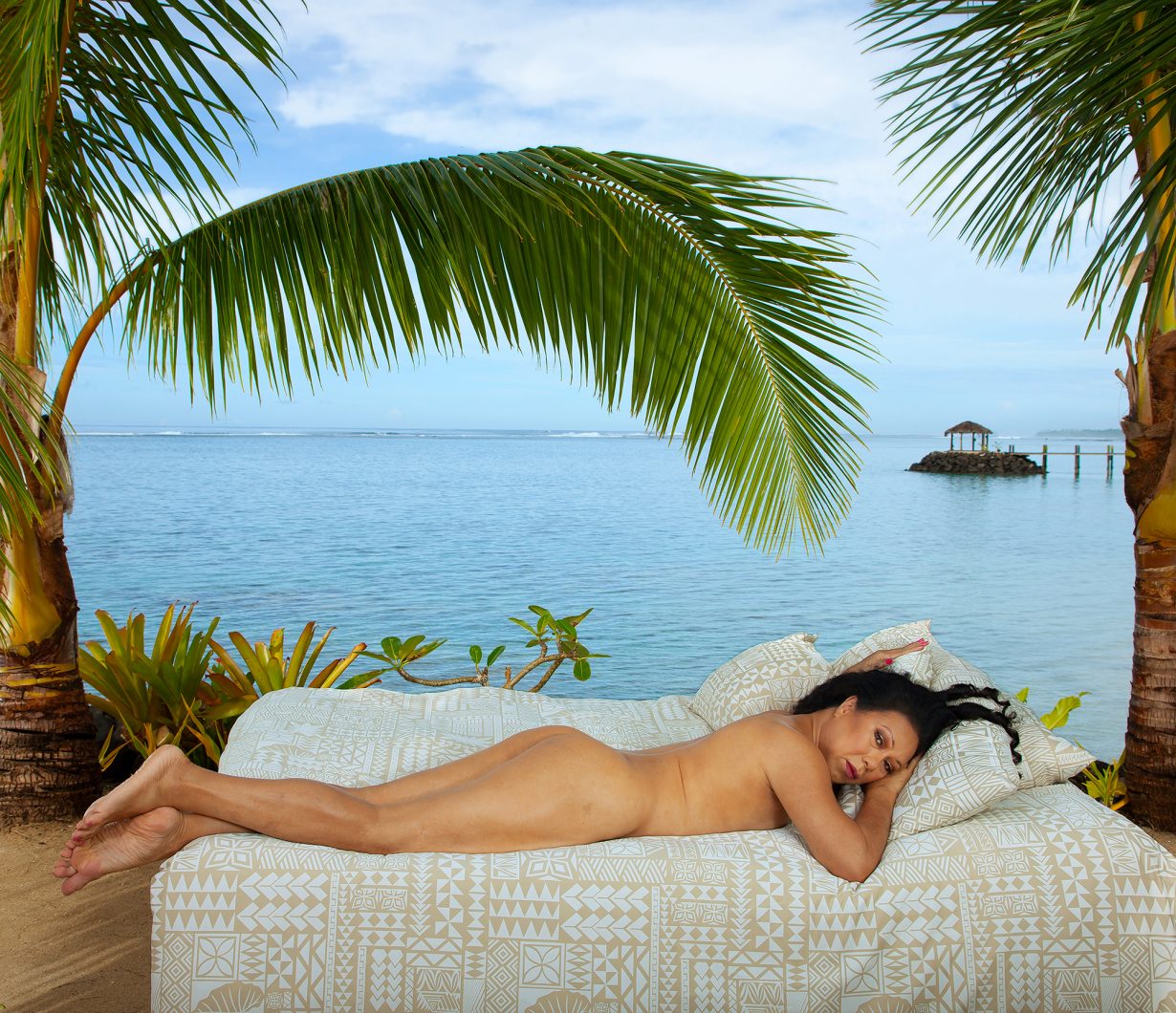
“Every time it moves to different places, Paradise Camp evolves to engage with the local community. When it toured to the Powerhouse Museum, I invited a Sāmoan diasporic drag queen, who I admired for a very long time, to participate: her name is Bertha,” says Kihara. To commemorate Bertha (aka Harold Samu) and her legacy as an activist, Kihara presented a new series titled BERTHA (2023). It’s made up of a collection of vintage dolls – found in thrift shops – that were modelled after “racial archetypes of Pacific Islanders” and upcycled by Kihara to chronicle all the outfits that Bertha wore during significant moments in her life: when she was marching for the decriminalisation of homosexuality in New Zealand (Law Reform Girl 1986), her work promoting awareness of HIV/AIDS among Pasifika peoples (Queens of the Pacific 1994), the first time Fa’afafine appeared on the runway in Aotearoa New Zealand at a major fashion event (Madame Butterfly 1995) and so on. The last doll in the series, Over the Rainbow 2023, wears the same outfit that Bertha wore during her performance at the opening of Paradise Camp.
In Sāmoa, “The Fa’afafine community not only managed the opening of the exhibition, but they also performed in front of the deputy prime minister and the leader of the opposition,” Kihara tells me. “It’s important for us to be visible in front of government officials and to hold them accountable, and for us to make sure that when they’re planning policies around climate change and sustainability, that they always have us in their hearts and minds.”

Kihara says that she could have “cut and paste” Paradise Camp from one location to another. But the artist is sensitive to how different audiences and communities can be engaged and made to feel welcome at her exhibitions – even down to making sure that institutions either have or are willing to install gender- neutral toilets. “Whenever I make a project or body of work, I ask myself: who is it that I want to empower with what I do?” she says. “When I created Paradise Camp, the people that I wanted to empower were people like me: Fa’afafine, but also trans, nonbinary, intersex people, people who didn’t fit into the binary. I wanted the exhibition to be an opportunity for the community to come together, to feel safe and to celebrate the fuck out, you know?”
The issue of empowerment partly boils down to visibility, in the sense of representation and recognition. Included in Kihara’s ever-growing archive project, usually presented across the walls of Paradise Camp with a kind of scrapbook aesthetic, is a series of the artist’s own passports, which show her sex listed as ‘M’, ‘X’ and then ‘F’ (‘By the way,’ she writes in the description alongside the passports, ‘F stands for Fa’afafine!’). Keeping a record of Fa’afafine culture and using this to platform significant figures in the community, Kihara calls this body of research a Vārchive – introducing the concept of Vā, which was described in 1996 by Sāmoan writer Albert Wendt as ‘the space between, the betweenness, not empty space, not space that separates but space that relates, that holds separate entities and things together’. While the concept was originally in reference to the way Sāmoans relate to and connect with one another, Kihara extends this to nonhuman entities that share diverse sex and gender traits too. Including fish. Part of the archive, first presented at the Venice Biennale, includes a panel that Kihara calls Fa’afafine Aquarium (2022), which depicts images of the sex-changing fish that, in part, inspired Darwin Drag.
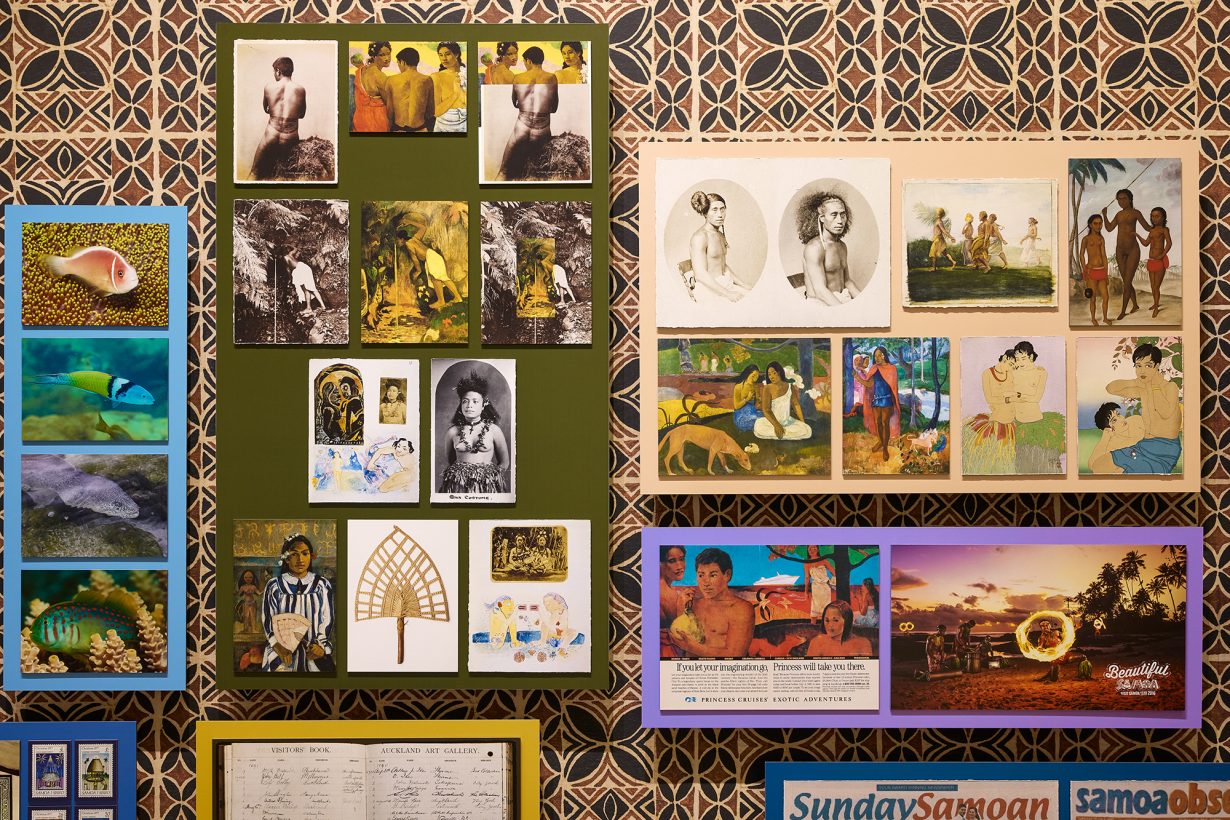
“Everybody knows who Charles Darwin is in the UK context,” says Kihara. “So I thought this is how I could engage with the British audience. Part of the research involved a site visit to the Natural History Museum in London, where I came across some of the fish specimens that Darwin collected in Tahiti in 1835. One of the fish he’d collected was a parrot fish, and that specimen will be presented alongside my work.” That parrot fish, roughly 13cm in length, is contained in a jar of preservative, its skin long leached of colour.
When I ask Kihara why, in Darwin Drag, BUCKWHEAT welcomes Darwin into the coral reef with open arms, instead of, say, taking a more obviously critical position against the biologist, she tells me, “Cisgender and straight people also suffer from heteronormativity, and these gender norms were secured by colonialism, imperialism, religion and the patriarchy.” It’s also, let’s face it, fun to see BUCKWHEAT “liberate” Darwin from such ideological constructions by allowing room for the hoary-haired biologist to wiggle around in a dazzling sequined dress while batting his eyelashes at his fish friends. What’s more, in transforming human-Darwin into fish-Darwin, Kihara makes reference to the dominant narrative of human hegemony over the animal world.
She tells me a story: Tagaloa, the supreme god, pulled the Pacific Islands up out of the ocean using a giant fishhook. Sāmoa was first inhabited by two males, who Tagaloa formed out of a pair of grubs. One day, while fishing, one of the men was bitten by a fish called a lō and died. His partner, devastated, begged Tagaloa to bring him back to life. The supreme god agreed, but instead brought the man’s partner back as a woman. Together the man and woman created the rest of humankind. “Heteronormative evolution is a colonial construct. My ancestors were ahead of their time – they already knew that all life was created from the ocean,” says Kihara. “What I’m trying to say is that we’re all part of one ecosystem.”
Darwin in Paradise Camp: Yuki Kihara is on view at Sainsbury Centre, Norwich, through 3 August
From the April 2025 issue of ArtReview – get your copy.
